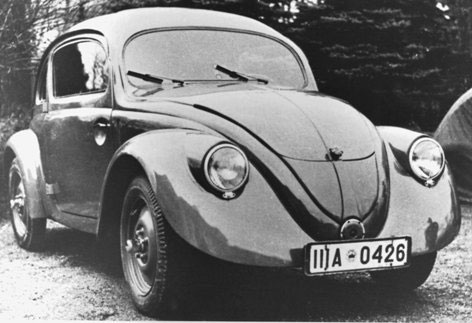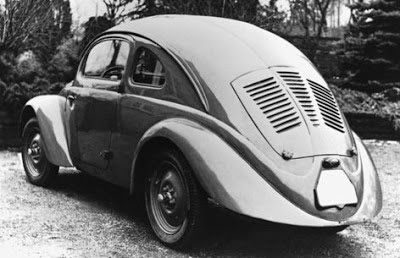 |
| The first prototype of the Beetle in 1935 was different from the production model, by Ferdinand Porsche. |
THE HISTORY OF THE BEETLE, really goes back to pre 2nd world war, when Adolf Hitler had a vision of a mass produced vehicle that was affordable to the average German. Started in 1934 when in the Hall of Berlin Adolf Hitler announced that the car had not to be an exclusive privilege of the rich. To Ferdinand Porsche, defined by him as “the most famous designer of all time”, he entrusted the assignment to construct the Volkswagen (the people’s car). Hitler was apparently influenced by the achievements of Henry Ford and his production lines – reading Ford’s biography while in prison during 1923.
On January 17, 1934, the German Reich government received a design proposal for a people’s car, a “Volkswagen” (German for ‘workers wagon’), from Ferdinand Porsche. It appeared feasible and shortly thereafter, Ferdinand Porsche received a contract from the German motor industry association (RDA) to deliver a prototype within 10 months.
 |
| There was no rear window and the doors were hinged at the rear. The bumpers and side boards were added later |
By October 1935 the first prototypes was completed but remained a secret, were on the autobahns, the V1 saloon and a convertible V2, these cars had aluminium bodies mounted over traditional wooden frameworks. In 1936 steel bodies mounted over all-steel floorpans were used, powered by a 984cc, 22bhp engine that could reach a top speed of around 65 mph.
The design would one day become one of the best-known symbols of German manufacturing quality but it was not apparent then. The car looked quite unusual, and very different from its final design. The distinctive split rear window (referred to as a “pretzel window”) and the running boards and bumpers were not as yet part of the design. The headlights were still separate units perched on the lid of the front luggage compartment. The doors were hinged at the rear and were only changed in the final prototype series in 1938 under American influence.
On May 26, 1938, Hitler ceremoniously laid the cornerstone of the foundation for the factory was laid near the town of Fallersleben. Although the construction of the production halls had begun in February because of time considerations, this was regarded as the official start of the construction what would become the largest car factory in the world under one roof.
On September 16, 1938, Volkswagenwerk GmbH was officially registered. Although the factory was in Wolfsburg, its registered address was in Berlin until 1948.
The first “people’s car” in its final form was produced and it was apparently the New York Times that called it the “Beetle” in an article on July 3, 1938.
At the end of the war, the factory came under the control of the Allies. On May 25, 1945, at the first meeting of the town council set up by the British, it was decided that the Volkswagen town would be given the name “Wolfsburg”. It then operated under the name of “Wolfsburg Motor Works”, a name chosen by Major Hirst and borrowed from the “Bayerische Motorenwerke” (BMW).
In Wolfsburg, it was intended to build complete cars. So the name “Wolfsburg Motor Works” did not last long. During this time, the factory was still used as a workshop for the repair of military vehicles and the building of jeep engines. On September 17, the British military authorities placed an order for 20,000 Volkswagens which gave impetus to the production and encouragement to the workers. By the end of that year, 1,785 vehicles were built, largely by hand.
The first real Volkswagens were built. These were civilian Beetles which were to be handed over to the Allied Control Commission for Germany as reparations. Other cars were supplied to German authorities like the Post Office, the German Red Cross and other institutions. However, the car was still not available to the general public.
The 10,000th Volkswagen produced since the war left the production line. It is interesting to note that in two weeks after the war ended, about the same number of vehicles was produced as in the whole of the previous 7 years.
In May 1948, the 25,000th Volkswagen left the production line. Slowly, the wheels of industry began to turn and Germany moved towards self-determination.
The factory decided to take part in the Hanover export fair with a view of selling the car outside Germany. This was an important decision when one considers the worldwide success of the car that was to follow. The first dealers and importers were the Pon brothers from Holland who were appointed 1947. Soon, the Beetle began appearing on roads in other European countries that were also fast recovering from the war. Exports grew and accounted for 23% of total production and brought in 21 million deutschmarks in foreign currency.
The Beetle was considered “classless”, an unconventional yet practical car for people all over the world. 21.5 million units based on the original design of Dr Porsche would be built until production finally ceased (in VW’s Mexican plant) in 2003, making it an automotive icon.
The Volkswagen Beetle, officially called the Volkswagen Type 1 (or informally the Volkswagen Bug), is an economy car produced by the German auto maker Volkswagen (VW) from 1938 until 2003. With over 21 million manufactured in an air-cooled, rear-engined, rear-wheel drive configuration, the Beetle is the longest-running and most-manufactured car of a single design platform, worldwide.